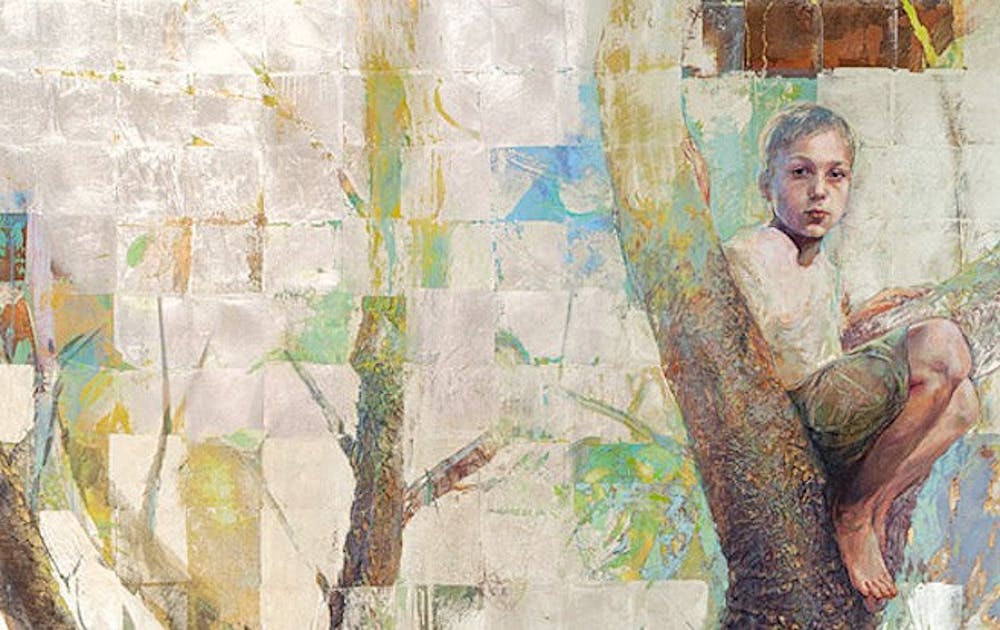It has been seventy years since the first publication of T.S. Eliot’s Four Quartets. Over time, the poem has been increasingly recognized as the poet’s magnum opus, his most impassioned attempt to find meaning in a world badly traumatized by two world wars. It’s a dark poem, at times ecstatic and intensely spiritual. For many artists, especially Christian artists, the work serves as a dependable source for inspiration and solace.
Next week’s exhibition “Engaging Eliot: Four Quartets in Word, Color and Sound,” presented by Duke Initiatives in Theology and the Arts (DITA), provides an opportunity to experience three artists’ interpretations of Eliot’s masterpiece. Makoto Fujimura and Bruce Herman have fashioned huge paintings in response to the poem, which will be the largest artworks ever mounted in the Duke Chapel. Yale composition professor Christopher Theofanidis has created a thirty-minute musical score for quintet. On Monday evening, in the presence of Fujimura and Herman’s massive paintings and bookended by short readings from Eliot’s poem, Theofanidis’ composition will be performed by the esteemed Ciompi Quartet and longtime pianist/DITA-director Jeremy Begbie.
The artists, all of Christian faith, have each had long personal relationships with Four Quartets. Fujimura—whose work combines modern painting styles reminiscent of Rothko and Pollock alongside old world Japanese techniques usually categorized under the genre Nihonga—turned to Eliot’s poem in response to trauma he experienced living two blocks from Ground Zero on September 11. The paintings he made for the exhibition are considered to be markedly different from his earlier works, and he seems to be responding to the darkness of Four Quartets.
“It’s a real turning point for Makoto,” said Christina Carnes, a student in the Divinity School who works for DITA. “He uses a lot of black. And he uses minerals as a material in a way that allows for a refraction of light that can be seen in person—a kind of mineral reflection.”
Unlike Fujimura’s abstract paintings, Bruce Herman’s use human figures and more straightforwardly express themes from Quartets, including the four seasons and the four elements of the ancient world. “His work may be more approachable, with more accessible emotions,” Carnes said. Theofanidis’ composition, like Eliot’s poem, utilizes repetition to disrupt notions of time. His score is titled “At the Still Point,” a phrase that comes from the first section of the four-part poem that discusses, among other things, methods to escape the psychological expectation of linear time.
In addition to Monday’s performance, there will also be a colloquium on Tuesday evening at which Duke professors will discuss the lasting impact of Four Quartets. On Tuesday afternoon, both the painters will talk to student artists about their work in the context of a brown-bag lunch. In total, the events are a chance for conversations about the theological ramifications of artistic works to take place beyond the boundaries of the Divinity School.
“I hope the Divinity School can be seen as a place where people of different views and perspectives on similar things can come together for enriching and fruitful conversations,” Begbie said. “For many people the arts are a great way into discussing the big questions of life and death. Because they’re allusive and metaphorical, they can give [people] room to explore things without feeling cajoled or battered.”
After seventy years, there may be no better way to honor Four Quartets and Eliot than to discuss with a wide community the type of Christianity and the type of art in which Eliot found comfort against the perils of his time.
“Engaging Eliot: Four Quartets in Word, Color and Sound” runs from Jan. 28 to Feb. 9 at the Duke Chapel and Divinity School. Visit the Divinity School website to register for Monday’s performance and Tuesday’s colloquium.
Get The Chronicle straight to your inbox
Signup for our weekly newsletter. Cancel at any time.

